the history of yeovil's pubs
PUBS HOME PAGE |
PUBS INTRODUCTION |
PUBS BY NAME |
BEERHOUSES |
three choughs hotel
5 Hendford
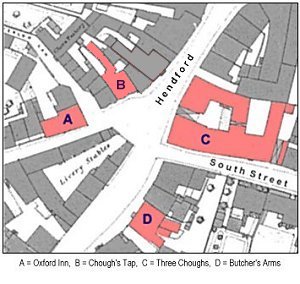 It
is not at first
clear when the
Three Choughs
(marked 'C' on
the 1886 map at
left) first
opened. There is
a date stone
from 1724 on the
South Street
elevation but
this is on a
three-storey
extension
clearly added
after the main
building
fronting
Hendford was
built. The
records,
however, clearly
indicate that
the Three
Choughs was
operating by
1664.
It
is not at first
clear when the
Three Choughs
(marked 'C' on
the 1886 map at
left) first
opened. There is
a date stone
from 1724 on the
South Street
elevation but
this is on a
three-storey
extension
clearly added
after the main
building
fronting
Hendford was
built. The
records,
however, clearly
indicate that
the Three
Choughs was
operating by
1664.
Indeed, by looking at the photographs below it appears that the third floor was added to the main building, possibly before the extension was added. Studying the fourth large photograph below it can be discerned that the stonework of the third floor wall is slightly coarser than the two floors below it - even though the building was re-fronted in 1845. Moving around into South Street the third floor is, of course, in brickwork with the three floor extension abutting it.
The building, as well as other licensed premises (the Pall Tavern and the George Inn), was at one time owned by the Woborn Almshouse and the rent of the building provided income for the Almshouse. During the 1850’s a daily stagecoach service, the 'Royal Mail', ran to Dorchester and Taunton from the Three Choughs. Until the 1960's the Three Choughs had stabling and garaging for customers horses and cars on the opposite corner, between Hendford and West Hendford.
|
Yeovilians
remember... "Saturday afternoons I invariably met Harry Box and rode on the Three Choughs Hotel 'bus (if the driver was in good humour) to Pen Mill Station and back, a thrill which we small boys thoroughly enjoyed. If we could not ride upon the 'bus, then we would spend the time vaulting the sheep pens at the market." |
Daniel Vickery, writing in 1856 remarked "The two principal Hotels are the Choughs and the Mermaid; and between these two establishments and the railway, omnibusses run to and fro, at the going out and coming in of each train. The Choughs Hotel (which is the property of the Almshouse, is now a very handsome building, the Feoffees having determined, on the 6th May, 1845, to take down the ancient front, and greatly to enlarge the accommodation. A number of men were set to work, and, it is said, pulled down the old frontage, and erected a new one in the short space of six weeks."
As a side note, the Chough features on the arms of the Duchy of Cornwall and often indicates ownership of the Duchy. However the Somerset dialect word for chough is becket, and three choughs were the arms of Saint Thomas Becket.
 At
left are two
undated public
house 'check' or
trade tokens
attributed to
the Three
Choughs Hotel.
The upper check
is early
Victorian and is
made of brass,
is 23.4mm in
diameter and has
a plain edge. On
the obverse it
says "C.R.S."
and its value -
3D. At this time
three old pence
could buy you a
good roast beef
dinner. On the
reverse is "M.
BULLEN" for
Maria Bullen who
was licensee of
the Three
Choughs Hotel
from at least
1830 until at
least 1861. The
lower check,
possibly later
eighteenth
century, is
tentatively
attributed to
the Three
Choughs Hotel.
It too is made
of brass, is
22.8mm in
diameter and has
a plain edge. On
the obverse is a
bird, presumably
a Chough, and on
the reverse "C
H" - presumably
the initials of
Chough's Hotel.
No denomination
is marked.
Checks were
frequently used
in games, such
as skittles or
quoits where,
for instance,
players would
'chip in' a
check to the
'kitty' which
would be won by
the winning team
to redeem at the
bar. By issuing
checks a
landlord could
guarantee they
would be spent
in his
establishment
only.
At
left are two
undated public
house 'check' or
trade tokens
attributed to
the Three
Choughs Hotel.
The upper check
is early
Victorian and is
made of brass,
is 23.4mm in
diameter and has
a plain edge. On
the obverse it
says "C.R.S."
and its value -
3D. At this time
three old pence
could buy you a
good roast beef
dinner. On the
reverse is "M.
BULLEN" for
Maria Bullen who
was licensee of
the Three
Choughs Hotel
from at least
1830 until at
least 1861. The
lower check,
possibly later
eighteenth
century, is
tentatively
attributed to
the Three
Choughs Hotel.
It too is made
of brass, is
22.8mm in
diameter and has
a plain edge. On
the obverse is a
bird, presumably
a Chough, and on
the reverse "C
H" - presumably
the initials of
Chough's Hotel.
No denomination
is marked.
Checks were
frequently used
in games, such
as skittles or
quoits where,
for instance,
players would
'chip in' a
check to the
'kitty' which
would be won by
the winning team
to redeem at the
bar. By issuing
checks a
landlord could
guarantee they
would be spent
in his
establishment
only.
In the Yeovil Guide of 1962 the Manor Hotel and the Mermaid Hotel were the most expensive hotels in Yeovil with Bed and Breakfast from 25/- per night (about £48 at today's value). For comparison the Three Choughs Hotel was 22/6 per night, the Pen Mill Hotel was 16/-, the Elephant & Castle Hotel was 15/6 and the Globe & Crown was cheapest at 14/6 (about £13.50 at today's value). By 1970 the prices were still the most expensive at the Manor Hotel with Bed & Breakfast from 45/- to 55/- per night (£50 to £63 at today's value), lunch at 14/6 (about £19) and dinner at 16/6 (about £22). Again for comparison, Bed & Breakfast at the Three Choughs Hotel was 42/- per night with breakfast only at 9/6 and tea from 3/6, the Preston Hotel was from 32/6 per night with lunch at 12/6 and dinner from 14/6, the Butchers Arms was 25/- for a single and 45/- for a double room per night and the Elephant & Castle Hotel was cheapest at 21/6 (about £29) per night.
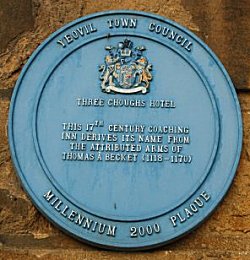 The following
description is
taken from the
Somerset
Historic
Environment
Record -
The following
description is
taken from the
Somerset
Historic
Environment
Record -
"Hotel, probably always a hostelry C18, re-fronted in 1845 and altered again later. Ribbon pointed squared local Stone having ashlar quoins to corners, with Welsh slate roof between coped gables, and brick chimney stacks. Entrance elevation of 3-storeys in 7-bays: central doorway (3 steps up, doors modern) slightly recessed in rusticated segmental archway with stone and cast iron balcony over, supported on stone brackets, and C20 porte cochere. Plinth now part buried. Ground floor has sash windows of 16 fairly large panes first floor windows have 12-panes and second floor 9-panes each: all set in simple architraves: the exception is the central 1st floor window which has French doors and is surmounted by a flat hood supported by console brackets. Interior not inspected. On prominent corner site; the South Street elevation incorporates a tablet inscribed "C.M. 1724" (sic).
The following is from an article in the Western Daily Press of 30 September 1975 -
|
Death in
a quiet
hotel
that
ruined
the
Lorna
Doone
writer Brother Henry, whose home was in north Devon, visited Yeovil from time to time, and invariably stayed at the Three Choughs Hotel. On this particular evening he returned to his room in acute pain. His condition apparently gave some concern: He was prescribed medicine by a local chemist and visited by a doctor. But by the next morning he was dead. And the post mortem revealed cyanide in the stomach. Intrigue increased when it was discovered that he had confided to the hotel "boots", as he staggered to his room: "People are plotting against me. They want to benefit from my will." The inquest was held at the Three Choughs and the coroner seemed in no doubt about his verdict. He decided that Blackmore's brother was of unsound mind and had taken the cyanide of potassium which, in turn, had added to previous exhaustion. Some unexpected news came out at the resumed inquest, on September 30, that put a different complexion on the case. Henry had become "fascinated by a fair Yeovilian while staying at the hotel." He had proposed to her and made out a new will, leaving something like £19,000 to her and her family. The girl's father had been named as the sole executor. And, yes, the father was none other than the chemist who had prescribed the medicine for Henry at the Yeovil hotel - Thomas Charles Maggs of the Medical Hall in the Borough. It was too much for Blackmore. He accepted that his brother was an incorrigible eccentric, who had already changed his will several times, and had even changed his name "after some family unpleasantness." But Richard Doddridge Blackmore, renowned for speaking his mind, angrily concluded that there were too many unhappy coincidences. This was no clear case of suicide, he told his literary friends. He pooh-poohed evidence at the inquest that Henry , when challenged by the doctor, had admitted taking poison. Blackmore wrote pointedly: "They say he poisoned himself. I say they poisoned him. Under his will he leaves all to the chemist in Yeovil, whose daughter he fell in love with and who had every motive to poison him." Even more uncompromisingly, he wrote in another letter: "This was vile, cold-blooded murder." The prompt result, not unsurprisingly, was the batch of libel actions. Blackmore, in poor health for most of his life, struggling financially with his fruit-growing and now making laborious work with his books, was driven to exasperation and near despair as the litigation dragged on. At the Probate Court it was disclosed that the last will of Henry had been made out only shortly before his death. Blackmore and others argued that it was invalid; the court ruled otherwise. A sum out of the estate, however, was made over to Blackmore, the sole next-of-kin. But there was still the libel to be sorted out. And, according to the evidence, the author of Lorna Doone had little defence. He wrote at the time "I am the victim of an odious law-suit brought against me by the medical man who did my brother to death at Yeovil." He also complained bitterly that vital witnesses had now been lost and importance evidence forgotten. Blackmore, who must have often regretted his display of public loyalty to his middle-aged eccentric brother, could not concentrate on his books. There is no way of telling how the libel was eventually settled. It didn't reach court after all, so Blackmore must have agreed privately. The doctor wanted £3,000 and he probably got half of it. It was money that Blackmore could ill afford, as his fruit-growing business failed. There was bitterness in his voice when he said, just before the settlement, "As I told the truth, I am sure to be beaten." The Three Choughs has never had a stranger guest, nor been the setting for such a notorious scandal. |
The Three Choughs closed in 2004 and has since been converted into offices and flats.
gallery
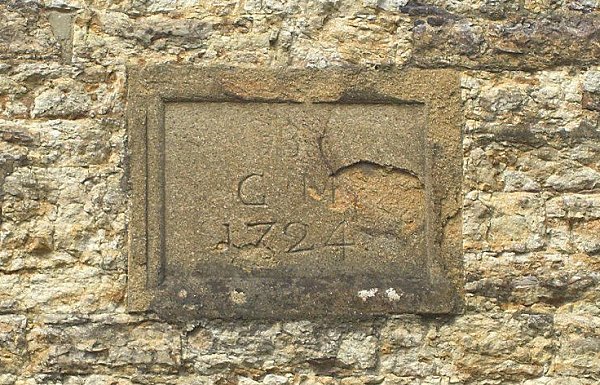
The date stone at high level on the south elevation of the extension, facing South Street. The inscription reads "B G M 1724".
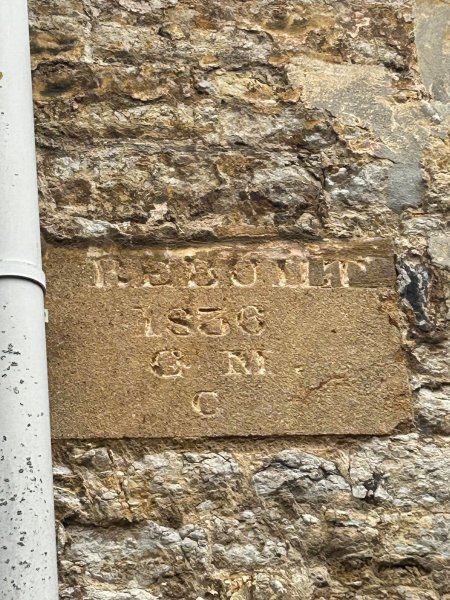
Courtesy of
Carrie-Ann Grant
A plaque inscribed "Rebuilt, 1836, GMC" on the wall of the communal area.
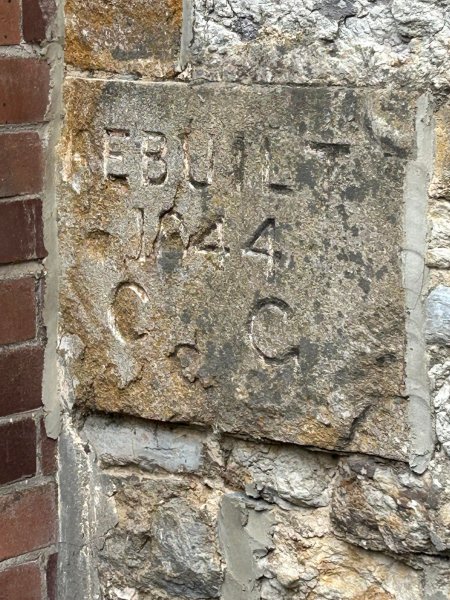
Courtesy of
Carrie-Ann Grant
Another plaque on the wall of the communal area, inscribed "Rebuilt, 1844, CC"
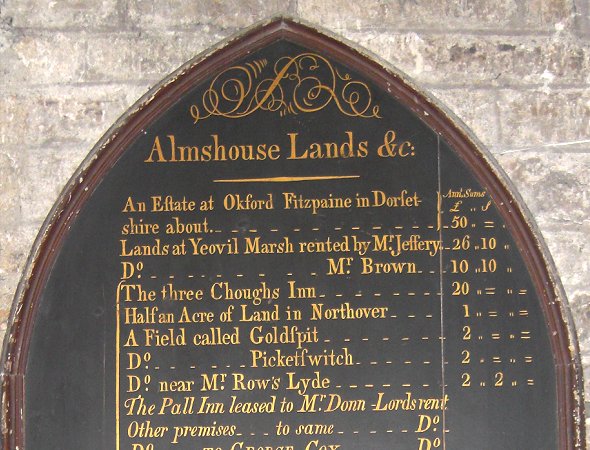
One of the four Charity Boards on the wall of St John's bell tower. Listing all the lands the Woborn Almshouse owned in 1804. The Three Choughs was valued at £20 per annum (around £18,000 at today's value).
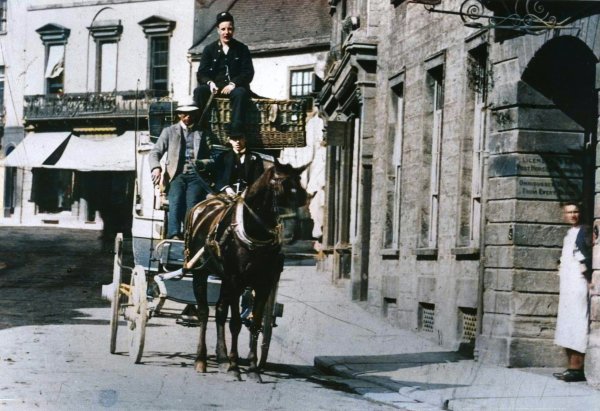
From the Cave
Collection
(colourised),
Courtesy of South Somerset Heritage Collection
A horse-drawn omnibus, used to transport guests to and from the railway stations, waits outside the Three Choughs Hotel in this sepia-toned photograph of about 1880. The driver sits on a wicker storage box. In the background the fine three-storey building to the left of the driver still stands today with the upper two storeys occupied by the High Street Dental Practice while the two-storey building behind the driver has been replaced by the building now occupied by the Britannia Building Society, seen in the photograph below.
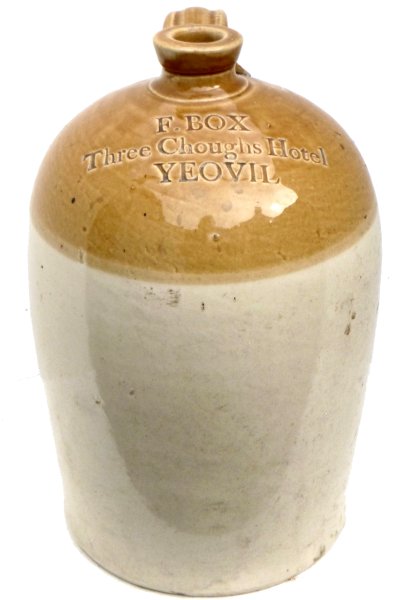
Courtesy of
Deborah Woodford
This is a twelve-inch-high one gallon jar, made by J & B Powell Ltd of 28 Redcliffe Street, Bristol. It dates to between 1895 and 1897, when Frederick Box was licensee of the Three Choughs Hotel.
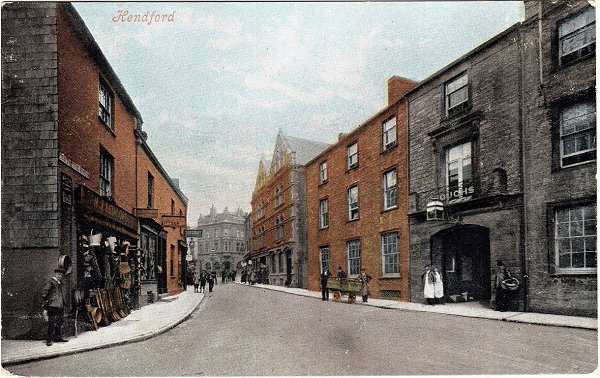
From my
collection
-
This photograph
features in my
book 'Yeovil From Old Photographs'.
A hand-coloured postcard of the same view of the northern end of Hendford dating to about 1905. At left is the ironmonger's shop of Henry James Sercombe who was listed as a 'tinman' in trade directories between 1903 and 1923. At right is the Three Choughs Hotel.

A postcard of Hendford dating to about 1908, by which time the Three Choughs is proudly announcing its 'Motor Accommodation' that was housed in its former stables at the junction of Hendford and West Hendford.
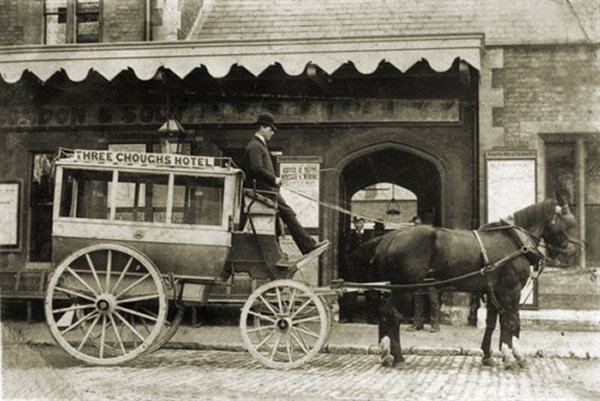
The Three Choughs Hotel's horse-drawn omnibus waiting for a train to arrive at Yeovil Town railway station. The Mermaid Hotel operated a similar omnibus service for its guests. These omnibuses were also available for hire in the evenings, especially for the dances and parties held at Christmas time. Both hotels had waggonettes of different sizes - the largest big enough to take cricket or football teams - which could be hired at short notice.
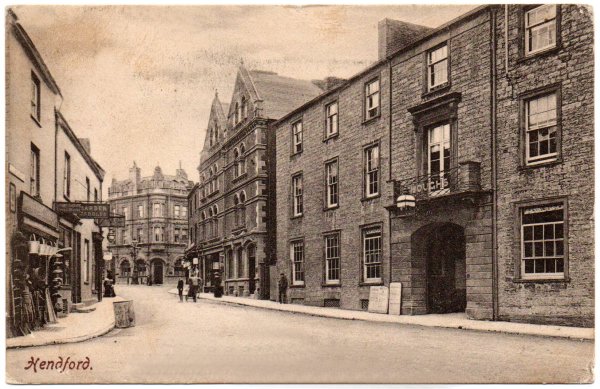
From my
collection
This postcard dates to 1909 and is a general view towards the High Street / Princes Street / Hendford junction. The Three Choughs Hotel is at right. At the far end of the street, on the corner of Princes Street and High Street stands the present Britannia Building Society building mentioned in the text of the photograph above as replacing the two-storey building. This edifice was built for the Capital and Counties Bank and opened in 1897. It was later occupied by the National Provincial Bank and then the Bristol and West Building Society.
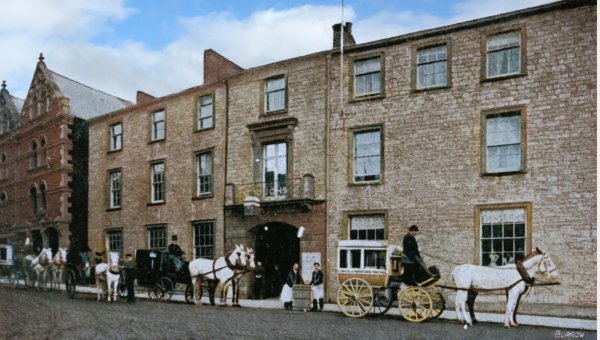
From my
collection
- This
colourised
photograph
features in my
book 'Yeovil
From Old
Photographs'
A postcard from at least 1905 (but this one posted in 1907) with the Three Cough's own horse-drawn carriages used to transport guests to and from the railway stations. The hotel had extensive livery stables and coach houses seen on the map above - diagonally opposite the hotel and located at the junction of Hendford and West Hendford.
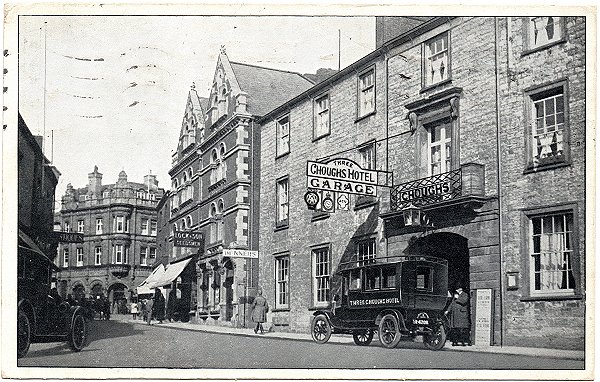
From my
collection
The photograph of this postcard is taken almost from the same viewpoint as the previous but around 1925. The postcard itself was posted in 1928. Notice outside the entrance to the Three Choughs is the hotel's own motor omnibus that met every train in and out of Yeovil to transport hotel guests.
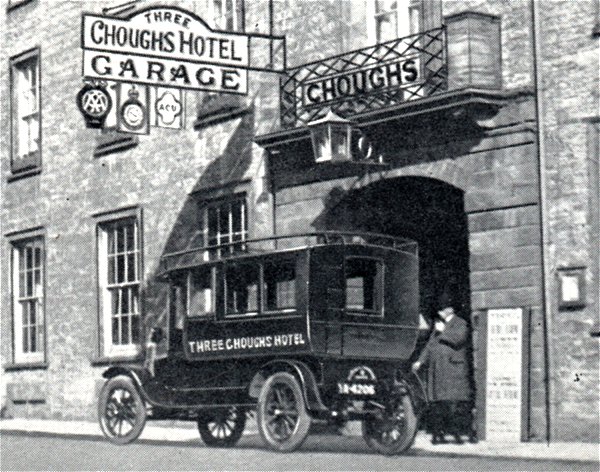
An enlargement of the previous photograph showing the Choughs' omnibus. Interestingly, the sign "Choughs" above the lantern over the doorway remains today, but is covered with a sheet of metal with no wording at all (many thanks to Carrie-Ann Grant for this snippet).
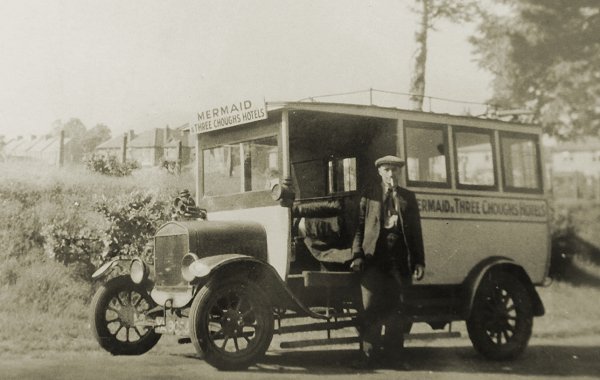
Courtesy of
Betty Barber
(née Bird)
By 1937 the Mermaid Hotel and the Three Choughs Hotel had combined their omnibus service to meet trains at each station. Because of its livery, this omnibus was known as the "Yellow Peril".
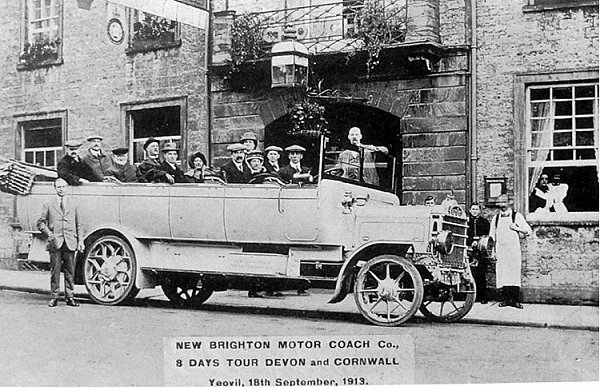
Clearly dated 1913 this photograph depicts a touring charabanc whose passengers enjoyed a night at the hotel. Then, as now, hotel staff loved to get into the picture as seen at right.
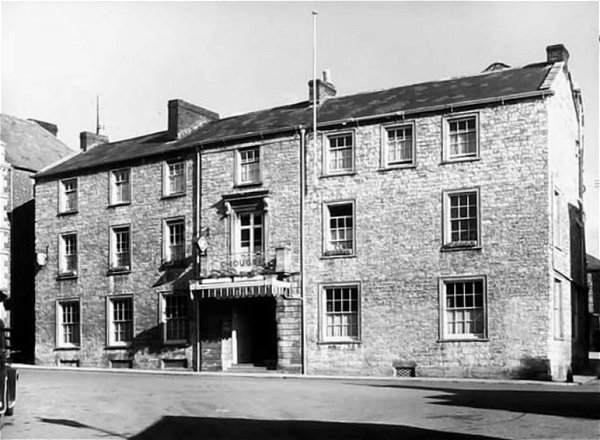
The Three Choughs Hotel, photographed in 1942.
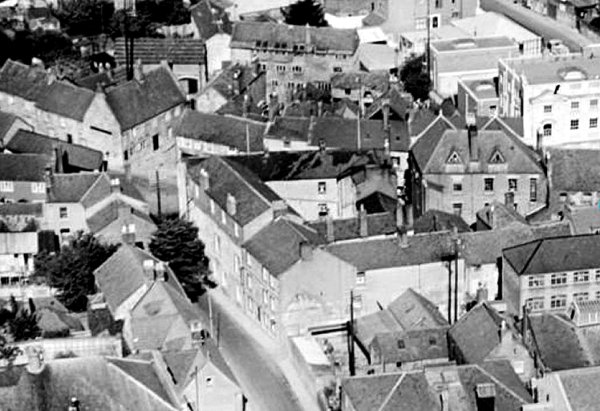
A 1928 aerial view of the western end of South Street, running from centre bottom towards centre left with the Oxford Inn clearly visible towards the top left corner of the photograph at the junction of Hendford, West Hendford, Waterloo Lane and South Street. The large building taking up most of the centre of the photograph is, of course, the Three Coughs Hotel. Notice the old glove factory in Waterloo Lane at top centre - one of the few remaining glove factory buildings in Yeovil.
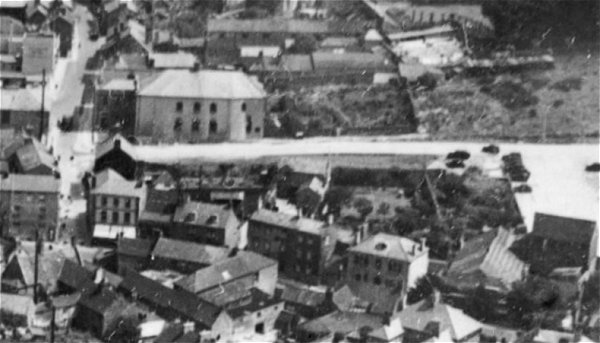
This aerial photograph dates to 1935 and shows Petters Way running across the photograph from South Street, at left, to the car park at right. Buildings of note are - the Greyhound Inn at very top left, the Baptist church at top left, the Three Choughs Hotel at centre left edge with the junction of South Street with Hendford to its right. On the opposite corner the buildings running along the east side of Hendford (with their street elevations facing us) are Chudleigh's seed merchants, the small shop that had been John Chaffey's photographic studio (later the WI Market), next to the Butcher's Arms. Next is Flower's House, then Ayr Villa and finally the furniture emporium known as The Rink owned by Henry White. Note that in the top right hand corner is the field that the Yeovil Law Courts and Police Station would be built on three years later, in 1938.
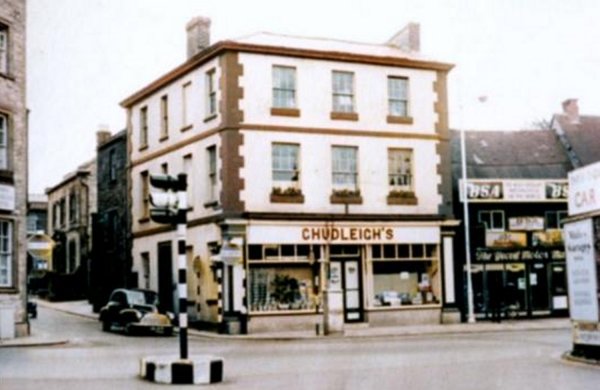
This
colourised photograph
features in my
book "Lost Yeovil"
This photograph, probably taken in the 1960's, shows how narrow South Street (with the car driving out of it) was at the time. The Three Choughs Hotel is at left. Chudleigh's Seed Merchants was demolished in the 1960's to widen South Street. Note at extreme right, on the corner of Hendford and West Hendford, the Three Choughs Hotel had its own car park for the use of patrons only on the site of its former livery stables.
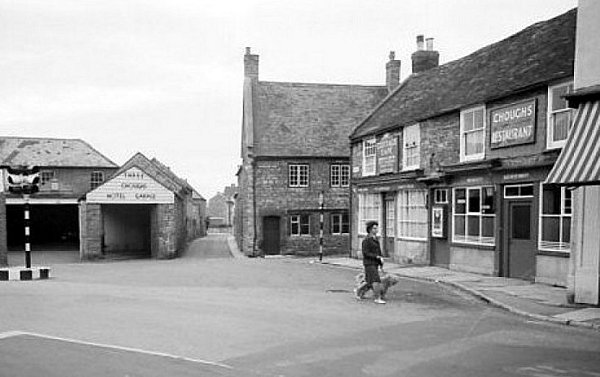
This photograph, taken around 1960, looks across Hendford and shows the very narrow entrance to West Hendford running alongside the Oxford Inn. Note that the Three Coughs Hotel (standing immediately behind the photographer) had a garage for patrons at left. This was the former livery stables of the Three Choughs Hotel. At right is the building housing the Cottage Café and the Choughs Restaurant.
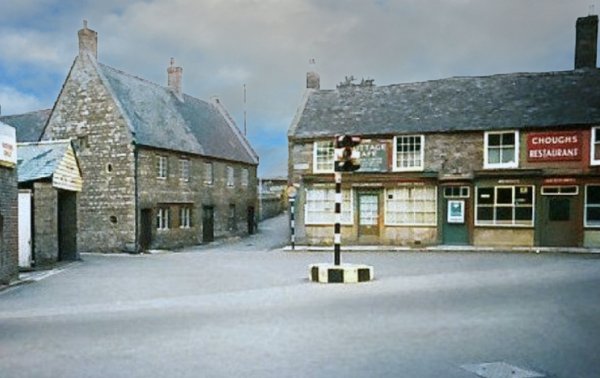
In this colourised photograph, again taken around 1960, the quaint roundabout with the traffic light had gone by the early 1970's - in fact when I moved to Yeovil in 1973 there were no traffic lights in the town whatsoever. Those were the days! Between the Cottage Café and the Oxford Inn is the entrance to Waterloo Lane.
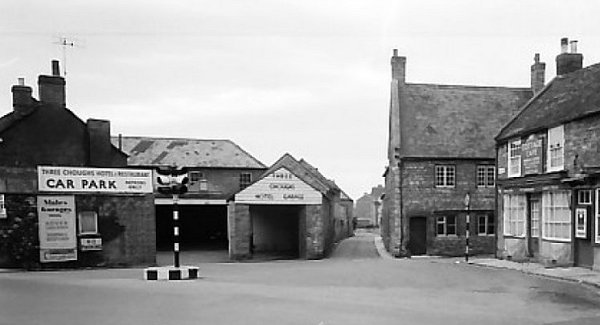
Seen from a different angle, the Three Choughs car park, the former stables, is seen with Hendford running off at the left and the narrow entrance to West Hendford at centre, next to which is the Oxford Inn, the even narrower entrance to Waterloo Lane and then the Cottage Cafe and Chough's Restaurant.
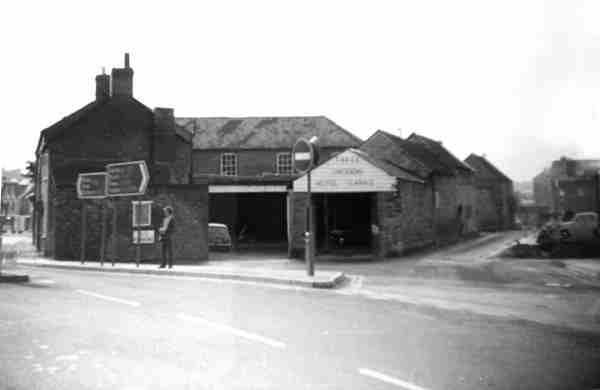
Courtesy of
Garth Baker
Taken a few years later, in the 1960s, after the Oxford Inn had been demolished and its site used as a temporary car park.
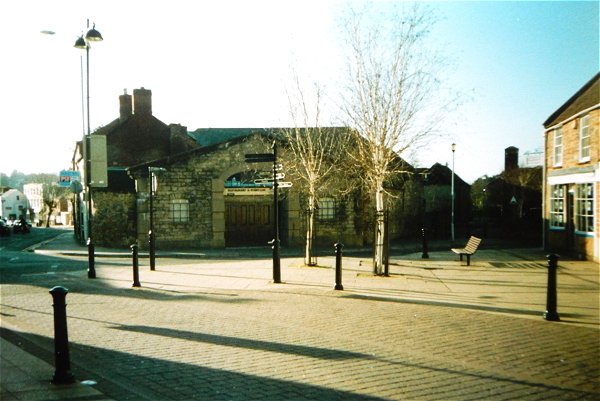
Courtesy of
Colin Haine
By the time of this 1984 photograph the former stables and garage had been converted to a nightclub - initially called the Camelot Suite in the early 1970s, then Oliver's in the late 1970s and finally the Electric Studios, or simply the Studios, in the early 1980s.
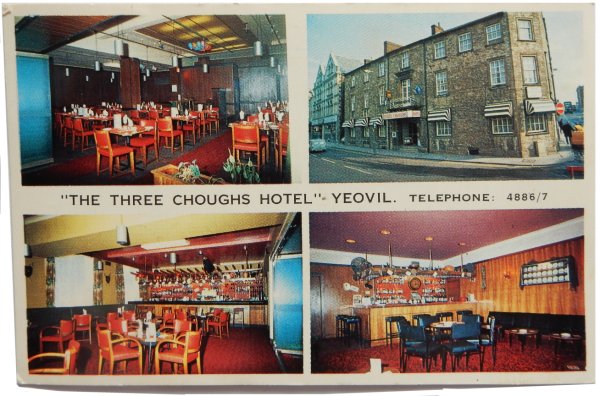
From my
collection
A 1970's multi-shot postcard showing the interior of the Three Choughs.
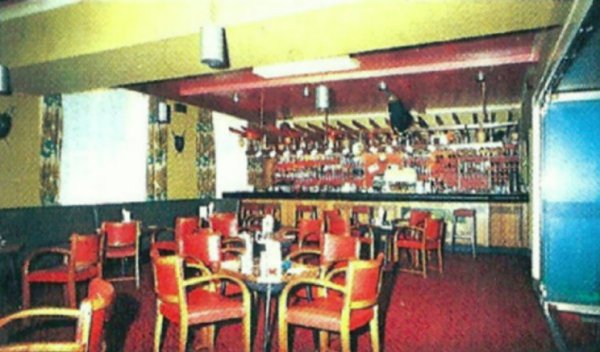
From my
collection
An enlargement taken from the above postcard. This photo shows the front bar - blimey that brings back some memories!
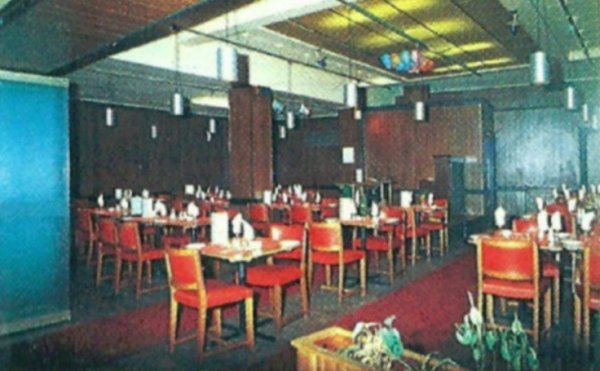
From my
collection
Another enlargement, this photograph shows the restaurant... and more memories - we had many a meal in here.
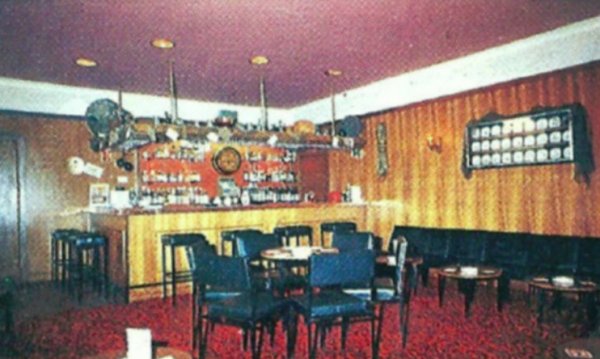
From my
collection
Final enlargement, this photograph shows the back bar.
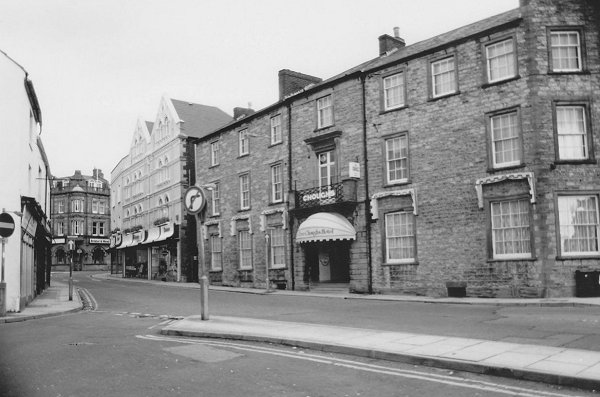
Photograph by
Trevor Hussey,
courtesy of Mrs
Anne Hussey
The Three Coughs Hotel, photographed in 1990.
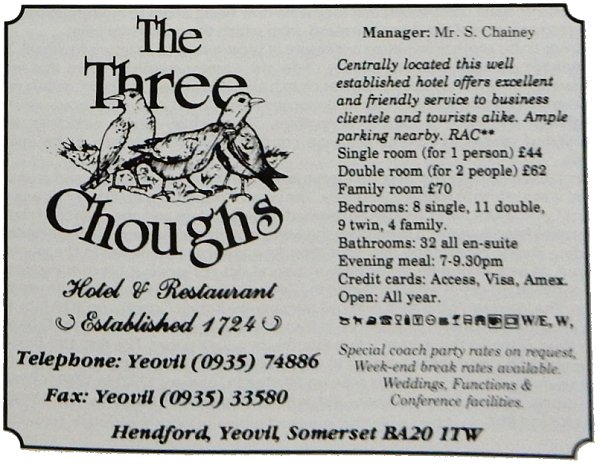
From my
collection
The Three Choughs' advertisement in the 1992 Yeovil Guide - interesting as it lists the numbers of rooms in the hotel and the rates. (They still got their own date of establishment wrong.)
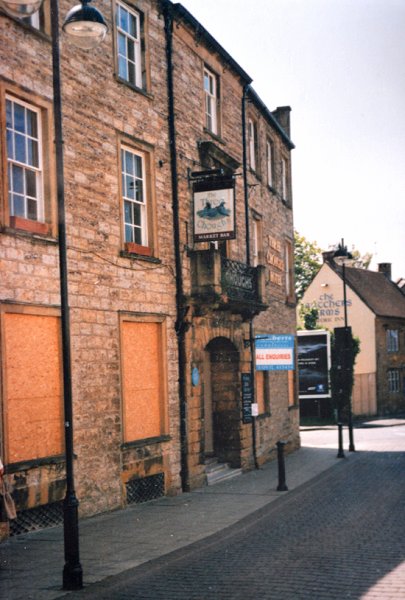
Courtesy of John
Cornelius
The Three Choughs, closed and shuttered in 2004.
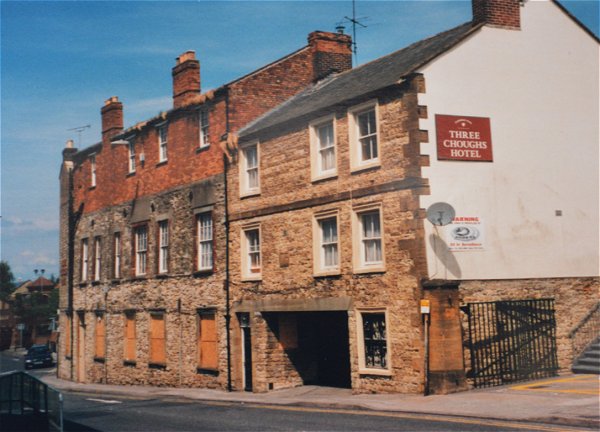
Courtesy of John
Cornelius
The south street elevation of the Three Choughs, closed and shuttered in 2004.
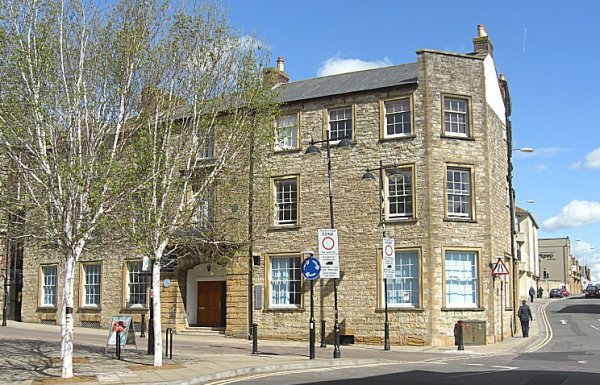
The Three Choughs Hotel building in 2012 - now converted to offices and flats. Note the difference in the stonework of the second floor.
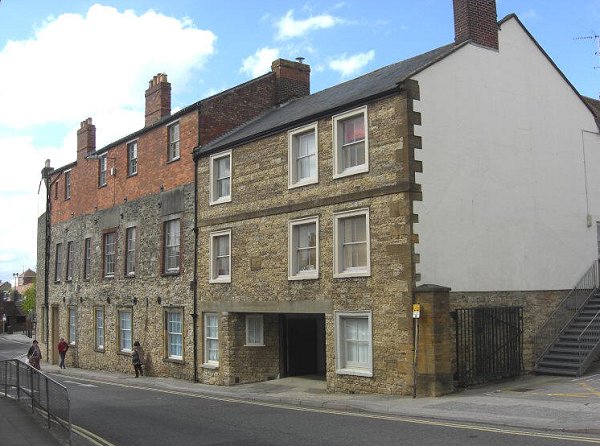
The rarely-photographed South Street elevation of the Three Choughs Hotel showing evidence for different stages of development. The date stone of the first photograph above is seen on the wall between the windows above the 20th century porte-cochere (the passageway through to the interior courtyard to you and me).
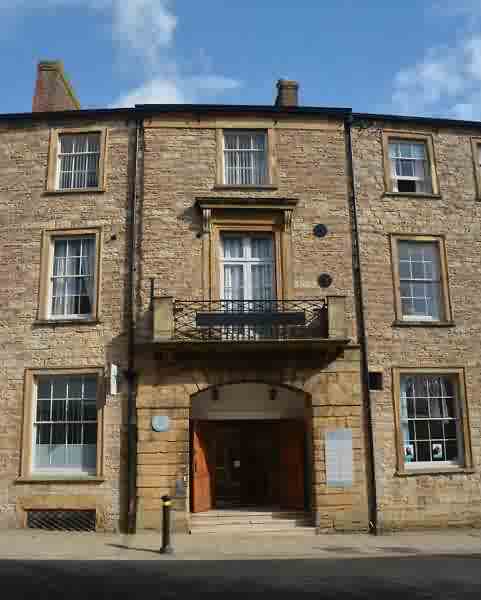
This photograph
features in my
book "Yeovil
In 50 Buildings"
The Hendford entrance to the former Three Choughs Hotel. Photographed in 2017.
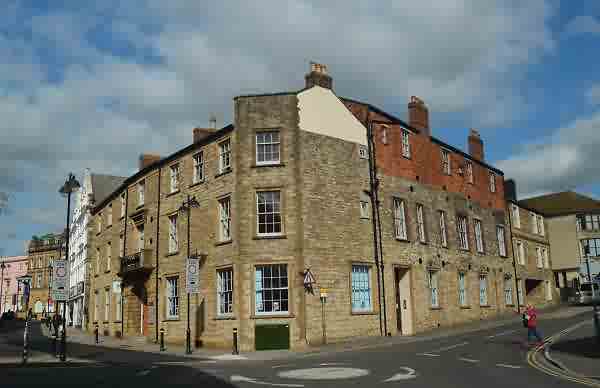
This photograph
features in my
book "Yeovil
In 50 Buildings"
The Three Choughs Hotel with Hendford running off to the left and South Street to the right. Photographed in 2017.
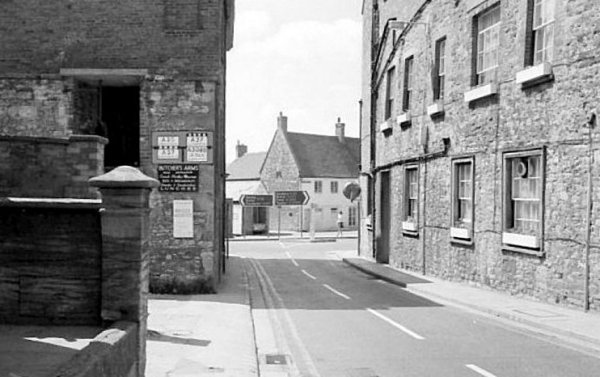
Taken in the 1960's, this photograph shows just how narrow South Street was at its junction with Hendford before Moffat Marine and Chudleigh's Seed Merchant on the corner opposite the Choughs were demolished - and it's even two-way traffic! The Oxford Inn is seen straight ahead with the Three Choughs Hotel at right.
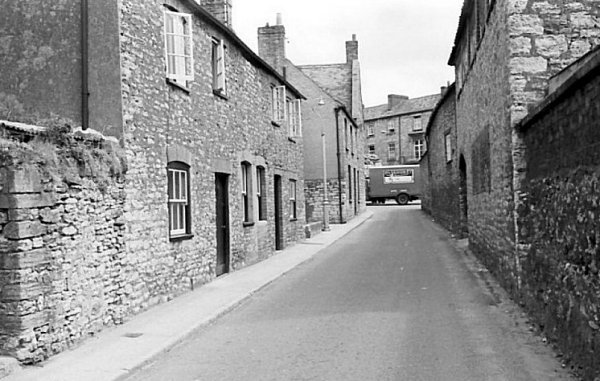
...and if you can't remember it, this is how narrow West Hendford was at its junction with Hendford. At the end of the road, beyond the van, is the Three Choughs Hotel. At the end of West Hendford, on the left just before the van is the Oxford Inn and all along the right hand side are the former livery stables and later garaging of the Three Choughs Hotel. Everything, apart from the Three Choughs, is now gone - including the van.
licensees
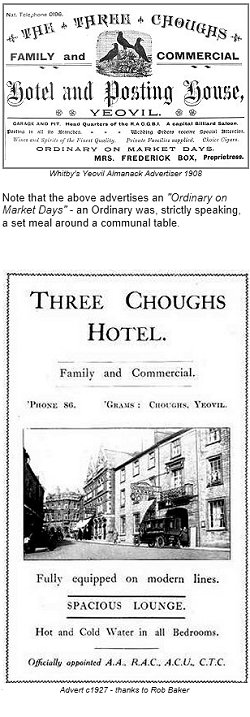 1664
– John Dyer
(Woborn
Muniments)
1664
– John Dyer
(Woborn
Muniments)
1667 – Widow
Dyer (Woborn
Muniments
1716 – Robena
Cary - 30s.
(Rent Book)
1724 – B.G.M.
(South Street
Date Stone) or
could
this be
the builder?
1744 – Mrs
Alford - 30s.
(Rent Book)
1747 – Mrs
Alford - 30s.
(Rent Book)
1760 – Mrs
Alford - 6½d.
Poor Rate Book)
1766 – Mr Abrams
(Poor Rate Book)
1776-87 - Mrs
Forward - £30
gross (Poor Rate)
1788-90 - Thomas
Martin (see the
last entry at
the
bottom of
this page)
1795 – H Bollen
- £20 net (Notes
of L Brooke)
1798 – Almshouse
owner, Hy Bollen
occupier
- £2 8s 3d (Land
Tax Return)
1796-1826 - Mrs
Bollon (Notes of
L Brooke)
1822 – Henry
Bullen (Pigot’s
1822 Directory)
listed
as
Choughs Inn and
Commercial
Tavern
1824 – Henry
Bullen (Pigot's
1824 Directory)
1828 – Yeovil
Almshouse, owner
- Maria Bullen,
occupier (Land
Tax Return)
listed as
Choughs Inn
1830 – Maria
Bullen (Pigot’s
1830 Directory)
listed
as
Choughs Inn
1831 – Yeovil
Almshouse, owner
- Maria Bullen,
occupier (Land
Tax Returns)
listed as
Three Choughs Inn
1839 – Maria
Bullen (Robson’s
1839 Directory)
listed as Three
Choughs Hotel
1841 – Maria
Bullen (age 55)
– Hotel Keeper
(1841 census)
1842 – Maria
Bullen (Pigot’s
1842-4
Directory)
listed as Chough
Inn (Commercial)
1851 – Marien
Bullen (Widow
aged 65) – Inn
Keeper (1851
census) with
son-in-law
Brett McTier
- Inn Keeper. Listed
as Three Choughs
1852 – Maria
Bullen – Inn
Keeper (Slater’s
1852 Directory)
Three Choughs
Inn (Commercial)
1861 – Maria
Bullen –
Landlady Hotel
Keeper (1861
census) listed
as Choughs Hotel
1866 – Maria
Bullen (Kelly's
1866 Directory)
1871 – Thomas Sharland – Hotel
Proprietor (1871
census) listed
as Choughs Hotel
1875 – Thomas Sharland
(Kelly's 1875
Directory)
1881 – Thomas Sharland – Hotel
Proprietor (1881
census) listed
as Three Choughs
Hotel
1889 – Thomas
Sharland
(Kelly’s 1889
Directory)
listed as Three
Choughs Hotel
1890 – Thomas Sharland
(Kelly's 1890
Directory)
1891 – Thomas Sharland – Hotel
Keeper (1891
census) listed
as Three Choughs
Hotel
1894 – License
transfer from
Thomas Sharland
to Frederick Box
(Petty Sessions)
- Box was
selected as
tenant by the
Trustees of
Woborn Almshouse
1895 – Frederick
Box (Kelly’s
1895 Directory)
listed as Three
Choughs Family &
Commercial
Hotel
& Posting House
(Frederick Box
was a
Freemason
and was
initiated into
Yeovil's
Lodge of
Brotherly Love
on 14 February
1894).
1897 – Frederick
Box (Kelly’s
1897 Directory)
listed as Three
Choughs Hotel
1901 – Catherine
Box – Hotel
Proprietor (1901
census) listed
as Choughs Hotel
1902 – Mrs Jane
Box (Kelly’s
1902 Directory)
listed as Three
Choughs Hotel
1908 – Mrs
Frederick Box –
Proprietress
(Whitby's Yeovil
Almanack
Advertiser 1908)
listed as
Three
Choughs Family &
Commercial Hotel
& Posting House
1911 – Mrs Box
(1911 census
Summary) listed
as Choughs Hotel
1912 – Mrs Jane
Box (Whitby's
1912 Yeovil
Almanack
Advertiser)
1914 – Frederick
Cole –
Proprietor
(Kelly’s 1914
Directory)
listed as Three
Choughs Family &
Commercial Hotel
1915 – Frederick
William Cole
(Whitby's 1915
Yeovil Almanack
Advertiser)
1920 – Hotel
sold by Woborn
Almshouse
Trustees
1923 – Frederick
Cole (Kelly’s
1923 Directory)
listed as Three
Choughs Family &
Commercial
Hotel
1936 – FW Cole
(1936 Yeovil
Directory)
listed as Three
Choughs Hotel
1938 – FW Cole
(1938 Yeovil
Directory)
listed as Three
Choughs Hotel
1939 – Eldridge,
Pope & Co Ltd -
Proprietors
(Kelly’s 1939
Directory)
listed as Three
Choughs Family
and Commercial
Hotel
1947 – Licensee
not named (1947
Yeovil
Directory)
listed as Three
Choughs Hotel
1949 – Licensee
not named
(Kelly’s 1949
Directory)
listed as Three
Choughs Hotel